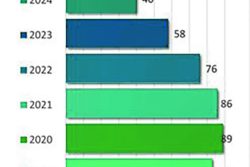During a recent consultative forum to discuss the draft of government’s Local Content Policy document, it came as no surprise that the issue of financing for the small business sector which, incidentally, comprises the bulk of the country’s private sector, surfaced as a topic for discussion.
The issues of access to funding and favourable funding terms for small businesses are not new, nor are they unique to Guyana. Even in countries with well-developed economies, these issues matter to millions of aspiring entrepreneurs. Here in Guyana, despite a wave of wide-ranging economic reforms, access to finance for small businesses remains a major constraint for the growth of the sector. As it happens, micro- and small-businesses are seen by traditional lending institutions as inherently risky. Many of these businesses operate in informal sectors and their owners often are perceived as lacking in business acumen. Their perceived shortcomings include an absence of know-how relating to the preparation of detailed financial statements and business plans, among other weaknesses. These types of business owners may also have difficulties in providing adequate collateral against which to effect meaningful borrowing.
Beyond these constraints, at the outset of their business operations, small business owners may realise low profit margins whilst many such operations are owned by first-time ‘triers’ or persons pursuing innovative products and services.
In engaging these types of businesses, commercial banks have come in for what, in the opinion of this writer, has been undue criticism. The banks are described, variously, as “unconscionable”, “conservative”, “barriers to development”, and “parasites”. These criticisms have to do with prohibitive interest rates applied in those instances when seemingly vulnerable businesses are fortunate enough to secure bank loans.
While some of these criticisms might be justified, account needs to be taken of the fact that commercial banks are themselves businesses guided by their own scale and scope of objectives for mitigating risk and maximising returns.
Rather than focusing criticisms on private lending institutions, I believe that there is need for us to turn our collective attention to another target, at the more deserving party, a party that has both the means and the responsibility to significantly improve the lot of small businesses… the government.
Over the years, the government has acknowledged the difficulties faced by small businesses insofar as financing their operations are concerned. While there have been some positive moves in the direction of seeking to remedy this problem there can be no question than that more can be done to nourish small businesses.
In 2013 the government finally operationalised the Small Business Bureau (SBB), nearly a decade after the Small Business Act (2004) was passed in the National Assembly. The Act articulated the legal framework for the SBB’s creation and paved the way for the establishment of the Small Business Development Fund (SBDF), which was tasked with providing “support and access to financing for small businesses”, along with institutional support and capacity building initiatives for small businesses.
Funding for the SBDF comes from several sources including government appropriation, grants received, revenue raised and investments administered by the Bureau. Since its establishment, the Bureau has disbursed 224 loans and 591 grants totaling $760 million and has facilitated capacity-building training programmes. When one considers the 815 beneficiaries who have received loans over the last eight years, it works out to around $932,000 per recipient and about 100 recipients per year.
Most recently, the Bureau invested $1 million each into 20 businesses under the auspices of its “Green Tech Fund.”
These are all commendable initiatives. However, the total volume of funds disbursed and the numbers of recipients are inadequate to cover the country’s large numbers of small businesses.
The government appears content and complacent with the SBDF’s current trajectory. This year, it has committed a meagre $250 million for the entire fiscal year to augment its obligations in fulfilling the SBDF mandate. Unless we have lowered our expectations and now accept that small businesses are to be stuck in low-level value-added production or output, then these meagre appropriations cannot be justified.
As some measure of light emerges from the COVID-19 tunnel and with the anticipated expansion of the hydrocarbons sector in addition to other new economic activities, attention will shift markedly towards improving the capacity of the private sector and better positioning local businesses to leverage opportunities available at home and abroad. The reality is that as Guyana’s economic landscape continues to shift, government will have to recognise this and to increase the resources available to the Small Business Development Fund by as much as tenfold. That will require, among other things, financing strategies involving government and commercial banks to meet demands in the private sector.
Next week, I will examine some initiatives which the government can take to broaden the base of access to financing for small businesses.
The author is a former President of the Georgetown Chamber of Commerce & Industry and a current Doctoral degree candidate in Business Administration.








